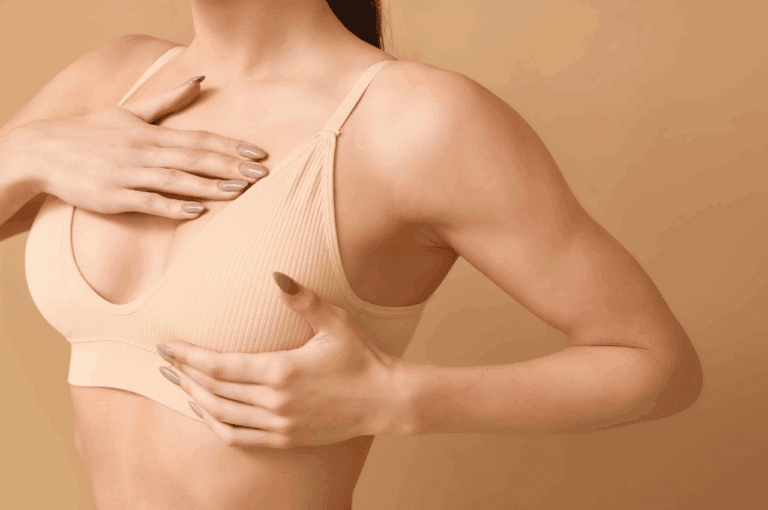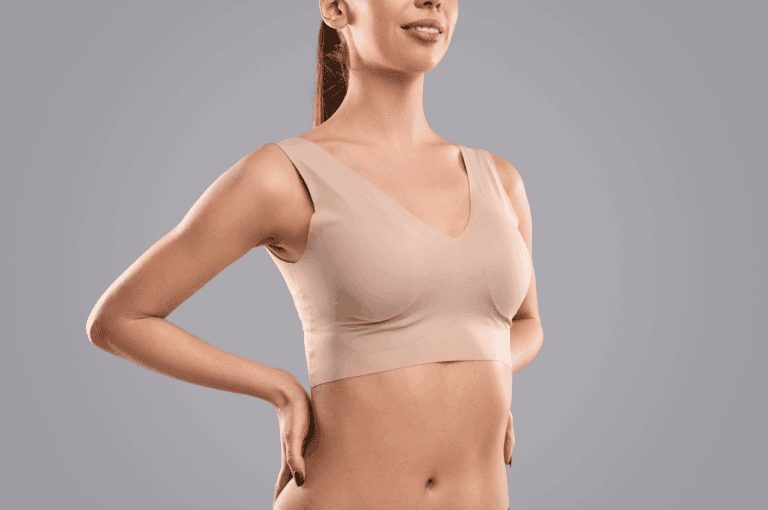If you are preparing for breast reduction surgery, choosing the right post-op bra is a decision that will affect your healing, comfort, and long-term results. At the New Jersey Breast Reduction Center, we understand how essential supportive, well-fitted bras are to the recovery process and your day-to-day wellbeing.
As you recover, your bra will play a major role in reducing discomfort, preventing complications, and helping your new contours settle beautifully. Let’s walk through everything you need to know to find the very best bras for your breast reduction recovery and beyond.
Key Takeaways
- Support is Crucial: The correct post-surgical bra provides consistent, gentle support to minimize swelling and discomfort.
- Surgical Bra Features Matter: Details like wide bands, front closure, and non-underwire cups make a significant difference during healing.
- Timing Your Bra Transitions: Wearing the right kind of bra at each stage of recovery is key for optimal results.
- Fit Over Fashion: Prioritize fit, comfort, and adjustability over appearance during the early recovery period.
- Long-Term Bra Choices: Once healing is complete, the right everyday bras keep your new shape comfortable and supported.
- Special Concerns: Make adjustments for sensitive skin, larger chest sizes, or if you experience swelling or tenderness.
- Consultation is Key: Individual anatomy and healing varies, so always follow post-op guidance from your breast reduction surgeon.
Why Your Bra Matters After Breast Reduction
The bra you wear in the days and weeks after surgery can impact both your comfort and your outcome. Post-surgical support is not just about lifting the breasts. It also helps control swelling, stabilize incisions, and protect delicate tissues as they heal.
Proper post-op bras minimize movement, which can decrease your risk of issues like fluid buildup, wound separation, and delayed recovery. A good bra also supports the new breast position and assists your body in creating soft, beautiful scars.
Finally, the ideal bra can help you feel more secure, confident, and comfortable, making the entire recovery process smoother.

Key Features of Recovery Bras
You want your recovery bras to deliver maximum support and comfort while protecting healing tissues. Understanding what features to look for will make your shopping decisions easier.
Front Closure vs. Back Closure
Most patients benefit from bras that open in the front. A front closure makes it much easier to put your bra on and remove it after surgery. This is especially helpful if arm movement is limited for the first week or two.
A back closure may be harder to manage post-surgery, but some patients find them comfortable and familiar. Nevertheless, we find that front-closure bras are usually the best choice for initial recovery.
Supportive Band and Wide Straps
Look for a bra with a broad, stable band that sits firmly but comfortably beneath your chest. The band provides the majority of breast support, taking pressure off incisions and healing tissue.
Wide, cushioned straps help distribute weight more evenly. They reduce strain on the shoulders and prevent uncomfortable digging, a key advantage as your body is still sensitive from surgery.
Non-Underwire Designs
You want to avoid any bras with underwires during the healing period. Wires can irritate your incisions and disrupt the recovery process.
A soft, structured cup without wires is the safest choice. It still gives shape and support, but will not cause pressure points beneath the breast.
Breathable, Soft Fabrics
Sensitive, healing skin benefits from materials that are soft, smooth, and breathable. Cotton, bamboo, or specific post-surgical fabrics help keep your skin dry and less prone to irritation or rashes.
Moisture-wicking and antimicrobial finishes offer additional comfort, especially if you tend to sweat or need to wear your bra 24 hours a day during early recovery.
Stages of Recovery: When to Wear Which Bra
Your bra needs change over the weeks and months following breast reduction. Here’s a closer look at the key milestones, and how your bra choices should adjust.
Immediately After Surgery (First 1-2 Weeks)
We typically provide a post-surgical compression bra for you to wear right after surgery. This bra is designed specifically to fit snugly and securely around your chest, keeping swelling minimal and supporting your new breast contours.
Expect to wear this bra day and night, removing it only for brief periods such as showering. Consistent support in these early days promotes healing, reduces discomfort, and helps incisions stay closed.
Weeks 2 to 6: Transition Phase
As swelling begins to subside and incisions heal, you can usually transition to a more standard post-surgical or sports bra. The focus here remains on gentle compression, adjustability, and comfort.
Choose bras that provide enough support but do not compress so tightly that they create pain or restrict lymphatic flow. Seamless, soft-cup bras made for post-surgical recovery are often a good fit during this stage.
After Complete Healing (6 Weeks and Beyond)
Once your surgeon confirms that your incisions are well healed and swelling has resolved, you may gradually explore regular bras again. You can reintroduce styles with light shaping or molded cups, but you still want to avoid stiff underwires or overly tight bands.
Many women find that their bra preferences change after breast reduction. You might be more comfortable in lower-coverage, wireless bras or may discover new options you never considered before surgery.
Types of Post-Surgical Bras
There are several categories of bras commonly used during breast reduction recovery. Let’s explore the main types and how they might work for you.
Compression Bras
Compression bras are often the first style you will use after surgery. Their firm, even pressure helps control swelling and keeps tissues stable.
These bras usually feature wide, adjustable straps and a substantial band for maximum support. They are typically made of soft, hypoallergenic fabrics and offer minimal seams to prevent irritation.
Surgical Recovery Bras
Many companies manufacture bras specifically for post-surgical use. These styles are similar to compression bras, but may be designed with additional features, such as special cup shapes to accommodate swelling, pockets for dressings, or openings to accommodate drains if your procedure requires them.
A good recovery bra often includes front or side closures for easier dressing and undressing during recovery appointments.
Sports Bras (Non-Underwire)
As you move past the first few weeks, a well-fitted, wireless sports bra can be an excellent option. Choose models with a zip or snap front for easier use and make sure the bra fits snugly but does not compress the breasts uncomfortably.
The most comfortable sports bras for post-surgical use have smooth seams, moisture-wicking material, and adjustable straps. Remember, underwire is usually discouraged until at least 8 weeks post-procedure.
Essential Qualities to Look for in a Recovery Bra
When shopping for a bra to support your recovery, pay close attention to a few non-negotiable qualities. These factors make a difference for daily wear and long-lasting comfort.
Comfort
Your recovery bra should feel soft against the skin and easy to put on and take off. Avoid scratchy seams, rough tags, or stiff bands, which can aggravate sensitive tissue.
Support, Not Compression
A good post-surgical bra will feel supportive and secure. You should not feel constriction or pain. Overly tight bras can restrict swelling from draining properly and can even impede healing.
Your bra should help maintain breast shape without feeling like a tourniquet.
Adjustability
Choose bras with adjustable straps and multiple closure positions. Swelling can fluctuate over the first few weeks, so the option to fine-tune band size and cup fit will keep you comfortable throughout recovery.
Washability
Expect to wash your recovery bra often, especially in the first weeks after surgery. Look for bras that hold up well to repeated gentle washing and do not lose shape or elasticity.
Easy-to-clean materials like cotton blends or high-quality synthetics tend to be most practical during this time.

Common Post-Surgery Bra Mistakes to Avoid
Finding the right recovery bra takes a bit of trial and error. Here are some missteps we see patients make most often. By avoiding these mistakes, you support better healing and a more comfortable experience.
- Choosing the Wrong Size: Post-surgical swelling can make sizing confusing. Use measurements taken just prior to surgery, or let our surgical team fit you for the right garment before you go home. Buying bras without updated sizing often leads to discomfort.
- Going Without a Bra Too Soon: Removing support too early can cause unnecessary discomfort and give less-than-ideal results. Keep your bra on as instructed by your surgeon, even while sleeping, during the early recovery phase.
- Wearing an Underwire Bra: Underwire can irritate healing incisions and interfere with recovery. Wait until your doctor approves wearing underwire again, usually after several weeks.
- Neglecting Hygiene: Your recovery bra will need frequent washing. Keeping your bras clean reduces risk of infection and helps sensitive skin stay rash-free.
- Prioritizing Fashion Over Function: While pretty bras are tempting, focus first on bras that serve your healing needs. Once you are fully healed, you can introduce more stylish options.
These pitfalls can delay healing and affect your comfort, so take your time in selecting the right bras for your post-reduction journey.
How to Determine the Ideal Fit After Surgery
Finding the perfect fit immediately after surgery often requires patience and a little help. Your breast shape and size will be very different from before, and some fluctuation in swelling during recovery is completely normal.
Measuring and Sizing
Have your measurements taken by a trained staff member at your follow-up appointment, or use a soft measuring tape at home as guided by your surgeon. You will want both band and bust measurements for the most accurate fit.
Adjust your expectations since you may need to update your bra size as recovery progresses and your final results become clearer.
Signs Your Bra Fits Well
You will know you have the right fit when:
- The band feels snug but not tight, resting low and even around your chest.
- The cups fully contain your breasts without bulging or gaping.
- Straps stay put but are not digging into your shoulders.
- You can breathe and move comfortably, with no poking or pinching.
If in doubt, bring in a few options to your next follow-up. Our surgical team is happy to guide you in making the best selection.
Frequently Asked Patient Questions
During recovery and bra shopping, you might encounter some of these common questions.
When Can I Stop Wearing My Surgical Bra?
Most patients need to wear a surgical bra day and night for at least two weeks. However, your exact timeline may differ based on healing. Only transition to a regular bra when you are cleared by your surgeon.
Can I Sleep Without a Bra?
During early healing, you will likely need to sleep in your surgical or post-surgical bra to keep swelling down and incisions stable. Once cleared, you may sleep without a bra if comfortable, or continue a wireless sleep bra for additional comfort.
Are There Special Bras for Sensitive Skin?
Some patients experience extra skin sensitivity, especially if they are prone to irritation or allergic reactions. Look for bras in hypoallergenic, seamless fabrics, and avoid elastic that touches the skin directly. Bamboo and high-quality cotton blends often work well.
Adapting Bra Choices for Special Situations
Most women find satisfaction with standard post-surgical bras, but specific needs may call for a custom approach.
Larger Chest Sizes
Patients with larger chest sizes may benefit from surgical bras with extra-long bands and reinforced straps. You can also look for brands that specialize in full-figure post-surgical lingerie for improved coverage and durability.
Ongoing Swelling or Tenderness
If you notice persistent swelling, tenderness, or fluid buildup, you might need a looser band or a bra that accommodates dressings. Contact your surgeon for assessment before changing your bra style.
Tips for Caring for Your Recovery Bras
Your recovery bras see frequent use, so caring for them is easy but important. Clean bras help prevent irritation and infection.
Washing
Always follow the care instructions provided by the manufacturer. Hand washing is preferred, using mild detergent and lukewarm water. Rinse thoroughly to remove all soap, and air dry bras flat to prevent stretching.
Rotation
Buy at least two to three quality post-surgical bras if possible. This way, you always have a clean option while others wash and dry, ensuring your comfort each day.
Beyond Recovery: Choosing Everyday Bras for Your New Shape
Once you are fully healed, you can enjoy shopping for bras that match your lifestyle, activity level, and style preferences. Your new silhouette may open up many new bra options.
Opt first for wireless support, bralettes, or soft-cup bras until you are fully comfortable. If you return to underwire bras, select those with soft padding and smooth seams to keep your skin happy.
Always prioritize comfort and proper fit above trends or appearance. Well-made bras not only enhance your result but also help maintain your health and comfort for years to come.
Ready for Comfortable Recovery and Results That Last
Selecting the best bras for breast reduction recovery is an important step toward an easy, successful healing process and results you will love. The right support enhances comfort, protects your incisions, and helps your new contours look their best for years to come.
At the New Jersey Breast Reduction Center, our surgeons and staff are always available to answer questions and guide you in choosing bras suited to your specific needs and surgery plan. If you would like more personalized support, we invite you to schedule a consultation, where we can guide you through every stage of your breast reduction journey, from surgery to everyday comfort.






